Abstract
1. B10 cells, a clonal line of rat brain capillary endothelial cells, exhibit a single P2 purinoceptor, activation of which leads to increases in free intracellular calcium. In the current study the identity of this P2Y receptor was determined by its binding parameters for a range of purinoceptor ligands and by its complementary DNA (cDNA) sequence. The signal transduction mechanism activated by this receptor was also investigated. 2. The radioligand [35S]-dATP alpha S bound with high affinity (Kd = 9.8 nM) to the P2Y purinoceptor expressed on B10 cells, which was found to be extremely abundant (Bmax = 22.5 pmol mg-1 protein). The calculated Ki values of a range of P2 purinoceptor agonists which competitively displaced binding of [35S]-dATP alpha S led to the rank order of affinity: dATP alpha S (Ki 3.4 nM) > 2-chloroATP (2-ClATP) (13 nM), ATP (22 nM) > ATP gamma S (43 nM) > 2-methylthioATP (2-MeSATP) (88 nM) > ADP (368 nM) > > UTP, L-beta,gamma-methyleneATP (both > 10,000 nM). The P2 purinoceptor antagonists, Reactive blue 2 and suramin, were also able to displace binding, with Ki values of 833 and 1358 nM respectively. In contrast pyridoxal-phosphate-6-azophenyl-2',4'-disulphonic acid 4-sodium (PPADS) was able to displace only 20% of [35S]-dATP alpha S binding at a concentration of 100 microM. 3. 2-ClATP (EC50 = 0.22 microM), 2-MeSATP (0.54 microM), ADP (7.9 microM) and ATP (a partial agonist), but not UTP, inhibited the cyclic AMP formation stimulated by cholera toxin, in a manner that was prevented by pertussis toxin. The purinoceptor antagonist, PPADS, was found to be inactive at a concentration of 100 microM. 4. A P2Y receptor cDNA was derived from mRNA from B10 cells and from C6-2B, a rat glioma cell line known to possess a P2Y receptor that is coupled to the inhibition of adenylate cyclase. Sequence analysis of the entire coding region revealed that both were 100% identical to the rat P2Y1 purinoceptor cDNA. No other P2Y-type receptor mRNA could be detected in B10 cells. Exactly the same sequence was isolated from rat brain cortical astrocytes, where 2-MeSATP has been shown to increase phospholipase C activity. 5. Since the receptor responsible for the transduction shares with the aforementioned binding site significant pharmacological features, including a strong activity of 2-MeSATP (characteristic of P2Y1 receptors alone among all known P2Y purinoceptors) and an unusual insensitivity to PPADS, and since abundant mRNA is present of the P2Y1 receptor but not of any other type resembling the known P2Y receptors, it is concluded that a P2Y1 receptor on rat brain microvascular endothelial cells can account for all of the observations. This single P2Y1 receptor, therefore, appears to couple in different native cell types to either adenylate cyclase inhibition or to phospholipase C activation.
Full text
PDF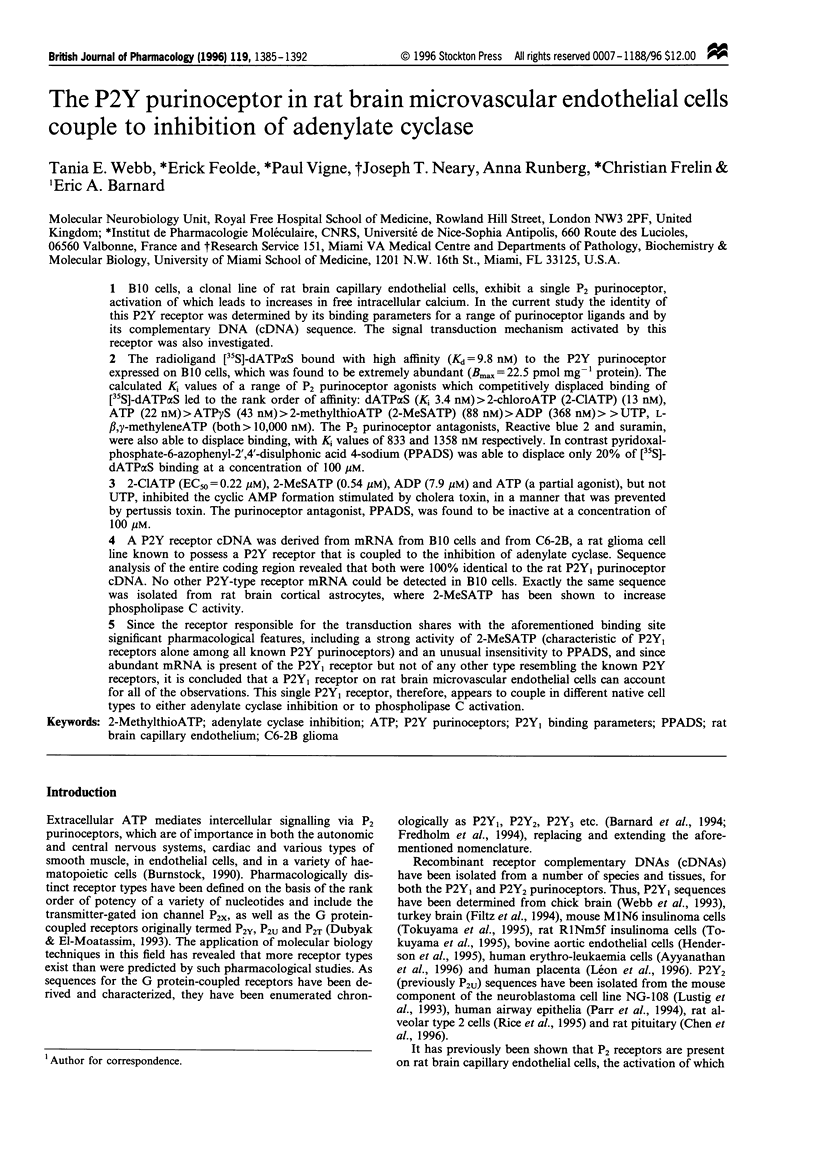
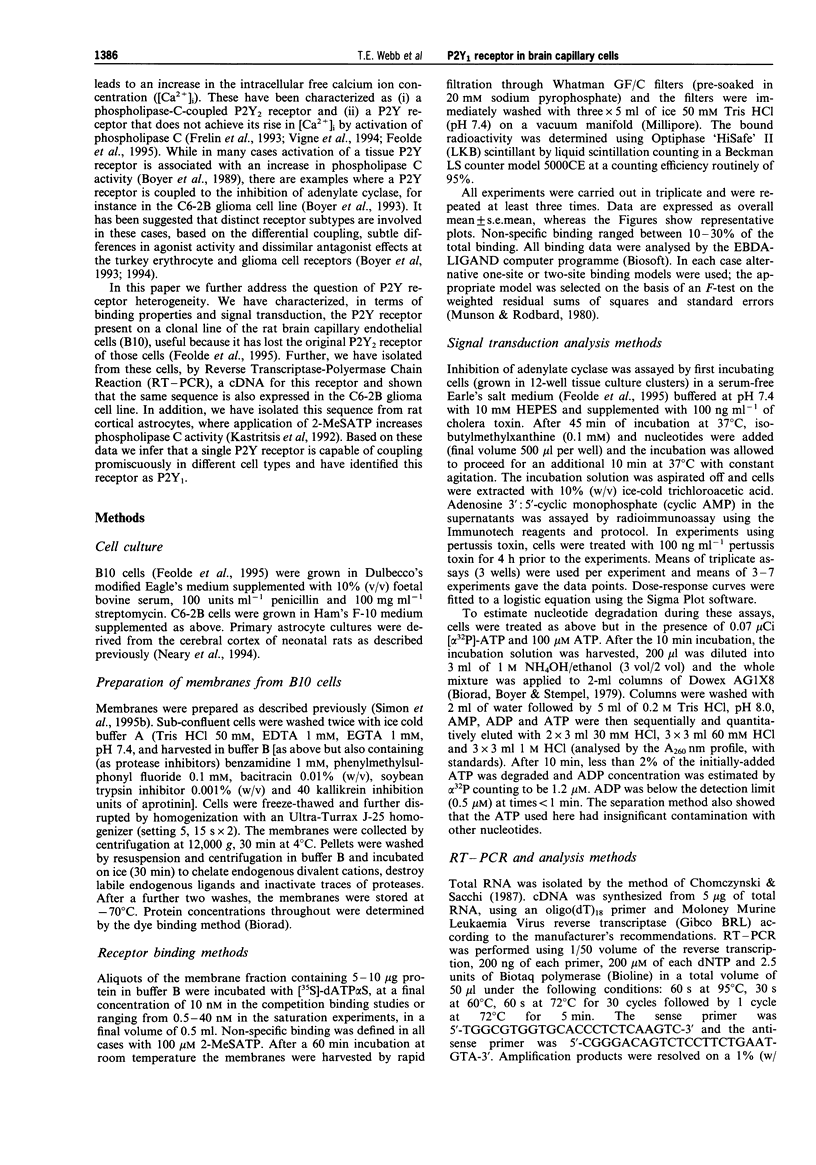
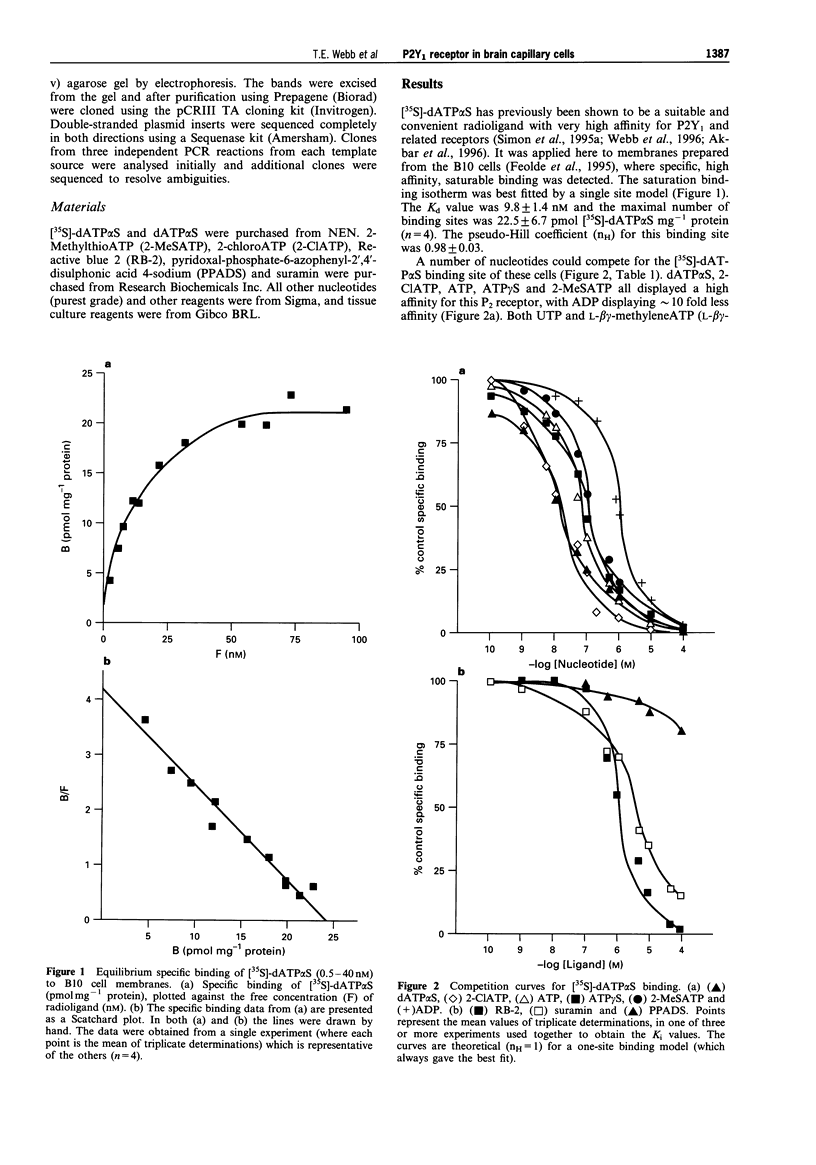
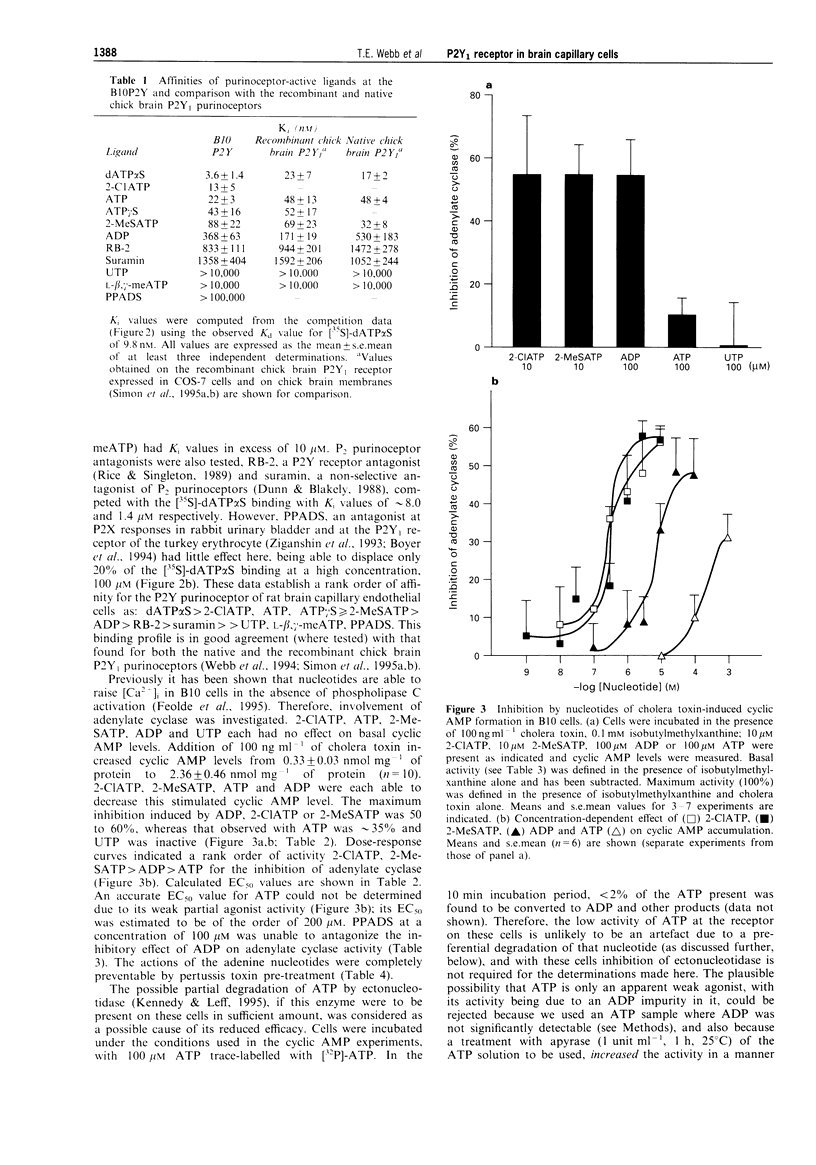
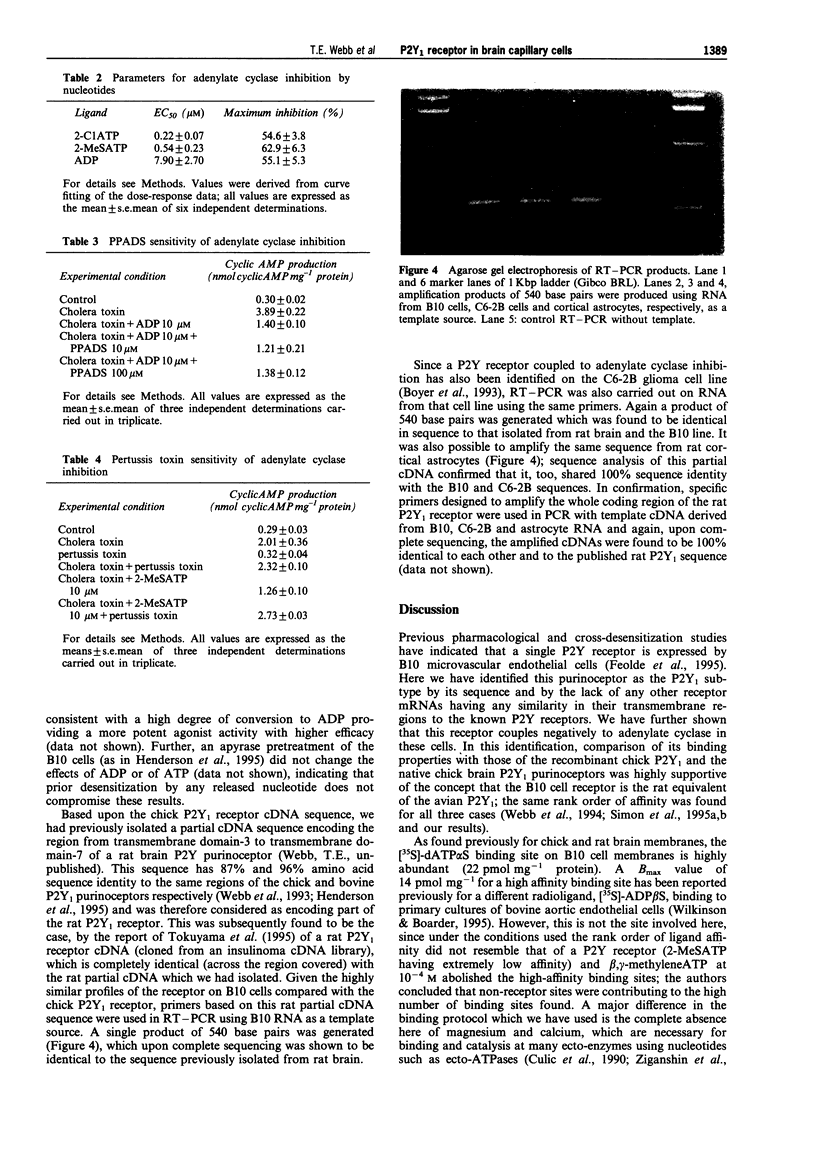
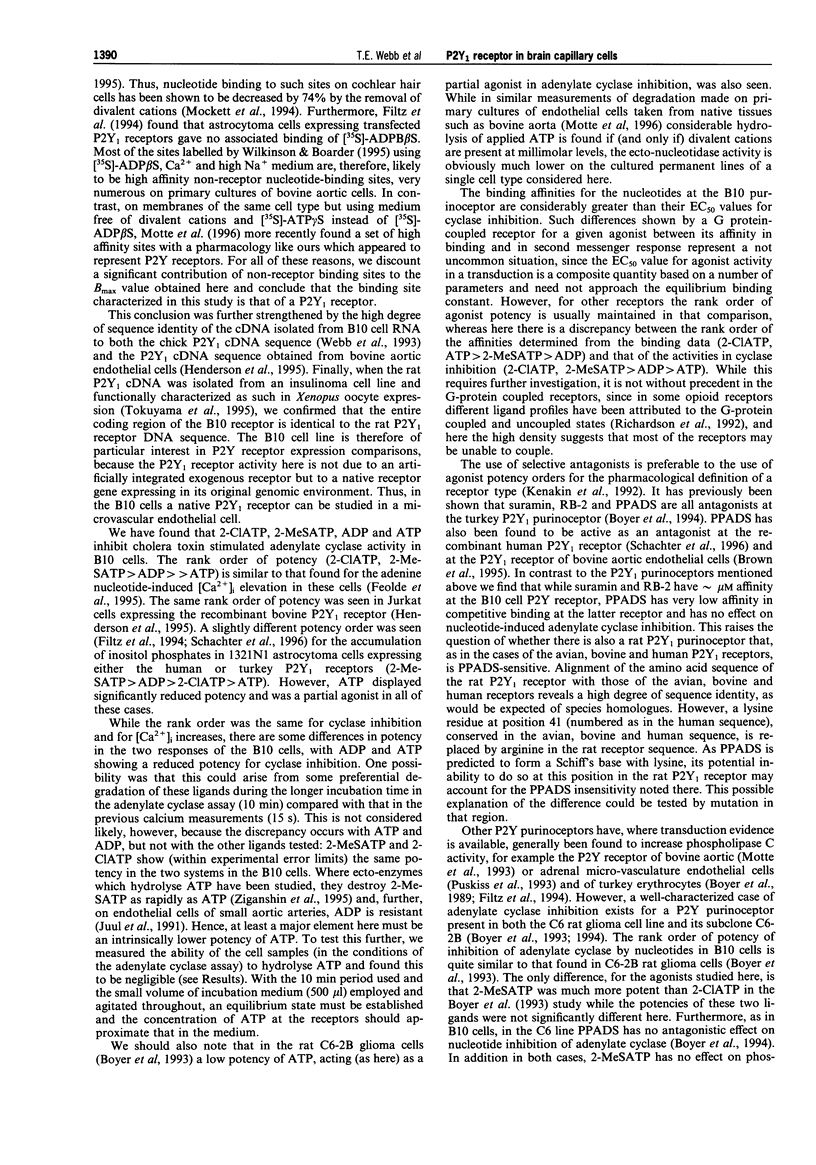
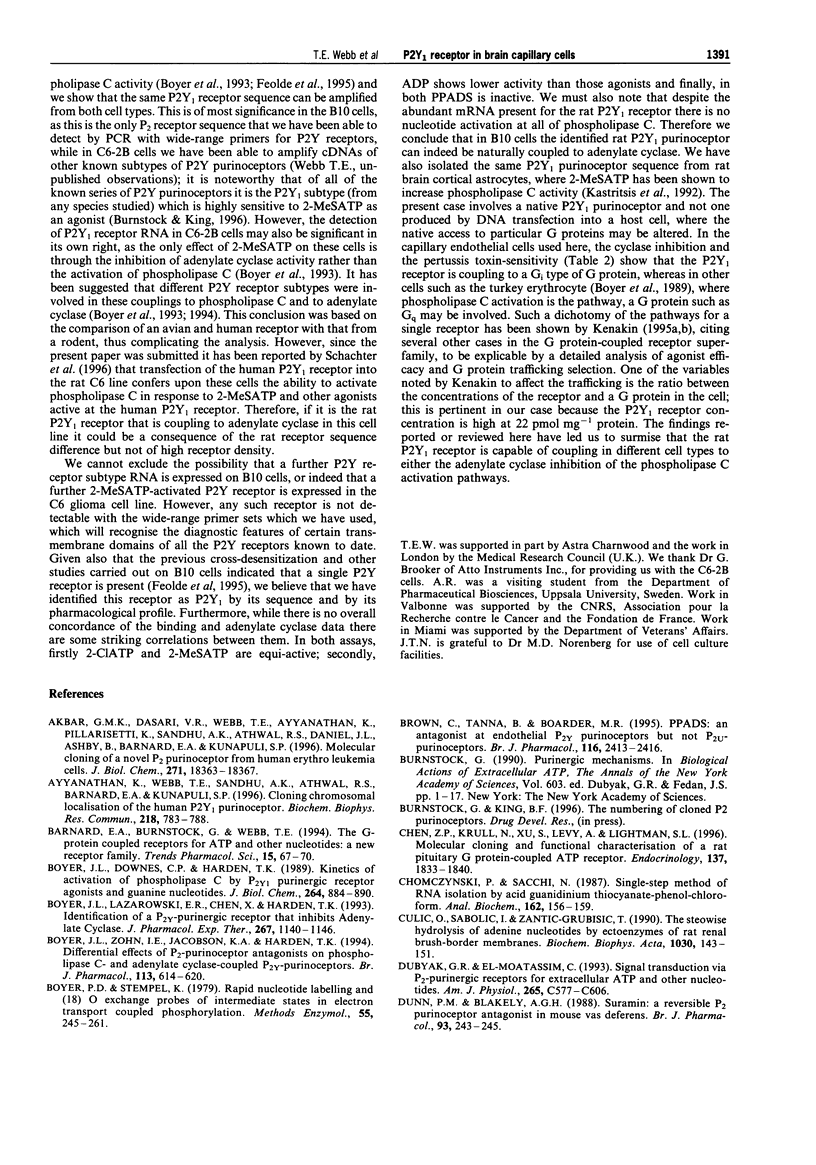
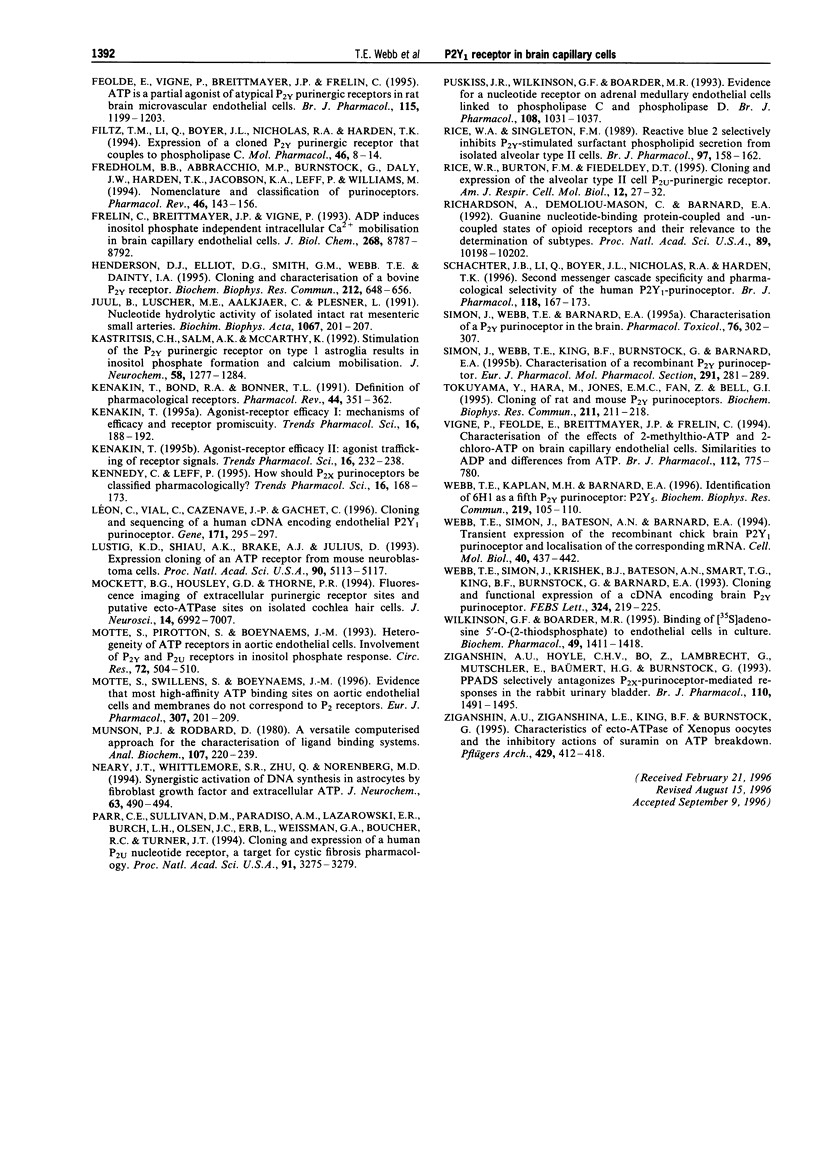
Images in this article
Selected References
These references are in PubMed. This may not be the complete list of references from this article.
- Akbar G. K., Dasari V. R., Webb T. E., Ayyanathan K., Pillarisetti K., Sandhu A. K., Athwal R. S., Daniel J. L., Ashby B., Barnard E. A. Molecular cloning of a novel P2 purinoceptor from human erythroleukemia cells. J Biol Chem. 1996 Aug 2;271(31):18363–18367. doi: 10.1074/jbc.271.31.18363. [DOI] [PubMed] [Google Scholar]
- Ayyanathan K., Webbs T. E., Sandhu A. K., Athwal R. S., Barnard E. A., Kunapuli S. P. Cloning and chromosomal localization of the human P2Y1 purinoceptor. Biochem Biophys Res Commun. 1996 Jan 26;218(3):783–788. doi: 10.1006/bbrc.1996.0139. [DOI] [PubMed] [Google Scholar]
- Barnard E. A., Burnstock G., Webb T. E. G protein-coupled receptors for ATP and other nucleotides: a new receptor family. Trends Pharmacol Sci. 1994 Mar;15(3):67–70. doi: 10.1016/0165-6147(94)90280-1. [DOI] [PubMed] [Google Scholar]
- Boyer J. L., Downes C. P., Harden T. K. Kinetics of activation of phospholipase C by P2Y purinergic receptor agonists and guanine nucleotides. J Biol Chem. 1989 Jan 15;264(2):884–890. [PubMed] [Google Scholar]
- Boyer J. L., Lazarowski E. R., Chen X. H., Harden T. K. Identification of a P2Y-purinergic receptor that inhibits adenylyl cyclase. J Pharmacol Exp Ther. 1993 Dec;267(3):1140–1146. [PubMed] [Google Scholar]
- Boyer J. L., Zohn I. E., Jacobson K. A., Harden T. K. Differential effects of P2-purinoceptor antagonists on phospholipase C- and adenylyl cyclase-coupled P2Y-purinoceptors. Br J Pharmacol. 1994 Oct;113(2):614–620. doi: 10.1111/j.1476-5381.1994.tb17034.x. [DOI] [PMC free article] [PubMed] [Google Scholar]
- Boyer P. D., Stempel K. Rapid nucleotide labeling and 18O exchange probes of intermediate states in electron-transport-coupled phosphorylation. Methods Enzymol. 1979;55:245–261. doi: 10.1016/0076-6879(79)55029-0. [DOI] [PubMed] [Google Scholar]
- Brown C., Tanna B., Boarder M. R. PPADS: an antagonist at endothelial P2Y-purinoceptors but not P2U-purinoceptors. Br J Pharmacol. 1995 Nov;116(5):2413–2416. doi: 10.1111/j.1476-5381.1995.tb15088.x. [DOI] [PMC free article] [PubMed] [Google Scholar]
- Chen Z. P., Krull N., Xu S., Levy A., Lightman S. L. Molecular cloning and functional characterization of a rat pituitary G protein-coupled adenosine triphosphate (ATP) receptor. Endocrinology. 1996 May;137(5):1833–1840. doi: 10.1210/endo.137.5.8612522. [DOI] [PubMed] [Google Scholar]
- Chomczynski P., Sacchi N. Single-step method of RNA isolation by acid guanidinium thiocyanate-phenol-chloroform extraction. Anal Biochem. 1987 Apr;162(1):156–159. doi: 10.1006/abio.1987.9999. [DOI] [PubMed] [Google Scholar]
- Culić O., Sabolić I., Zanić-Grubisić T. The stepwise hydrolysis of adenine nucleotides by ectoenzymes of rat renal brush-border membranes. Biochim Biophys Acta. 1990 Nov 30;1030(1):143–151. doi: 10.1016/0005-2736(90)90249-n. [DOI] [PubMed] [Google Scholar]
- Dubyak G. R., el-Moatassim C. Signal transduction via P2-purinergic receptors for extracellular ATP and other nucleotides. Am J Physiol. 1993 Sep;265(3 Pt 1):C577–C606. doi: 10.1152/ajpcell.1993.265.3.C577. [DOI] [PubMed] [Google Scholar]
- Dunn P. M., Blakeley A. G. Suramin: a reversible P2-purinoceptor antagonist in the mouse vas deferens. Br J Pharmacol. 1988 Feb;93(2):243–245. doi: 10.1111/j.1476-5381.1988.tb11427.x. [DOI] [PMC free article] [PubMed] [Google Scholar]
- Feolde E., Vigne P., Breittmayer J. P., Frelin C. ATP, a partial agonist of atypical P2Y purinoceptors in rat brain microvascular endothelial cells. Br J Pharmacol. 1995 Aug;115(7):1199–1203. doi: 10.1111/j.1476-5381.1995.tb15025.x. [DOI] [PMC free article] [PubMed] [Google Scholar]
- Filtz T. M., Li Q., Boyer J. L., Nicholas R. A., Harden T. K. Expression of a cloned P2Y purinergic receptor that couples to phospholipase C. Mol Pharmacol. 1994 Jul;46(1):8–14. [PubMed] [Google Scholar]
- Fredholm B. B., Abbracchio M. P., Burnstock G., Daly J. W., Harden T. K., Jacobson K. A., Leff P., Williams M. Nomenclature and classification of purinoceptors. Pharmacol Rev. 1994 Jun;46(2):143–156. [PMC free article] [PubMed] [Google Scholar]
- Frelin C., Breittmayer J. P., Vigne P. ADP induces inositol phosphate-independent intracellular Ca2+ mobilization in brain capillary endothelial cells. J Biol Chem. 1993 Apr 25;268(12):8787–8792. [PubMed] [Google Scholar]
- Henderson D. J., Elliot D. G., Smith G. M., Webb T. E., Dainty I. A. Cloning and characterisation of a bovine P2Y receptor. Biochem Biophys Res Commun. 1995 Jul 17;212(2):648–656. doi: 10.1006/bbrc.1995.2018. [DOI] [PubMed] [Google Scholar]
- Juul B., Lüscher M. E., Aalkjaer C., Plesner L. Nucleotide hydrolytic activity of isolated intact rat mesenteric small arteries. Biochim Biophys Acta. 1991 Aug 26;1067(2):201–207. doi: 10.1016/0005-2736(91)90044-9. [DOI] [PubMed] [Google Scholar]
- Kastritsis C. H., Salm A. K., McCarthy K. Stimulation of the P2Y purinergic receptor on type 1 astroglia results in inositol phosphate formation and calcium mobilization. J Neurochem. 1992 Apr;58(4):1277–1284. doi: 10.1111/j.1471-4159.1992.tb11339.x. [DOI] [PubMed] [Google Scholar]
- Kenakin T. P., Bond R. A., Bonner T. I. Definition of pharmacological receptors. Pharmacol Rev. 1992 Sep;44(3):351–362. [PubMed] [Google Scholar]
- Kenakin T. Agonist-receptor efficacy. I: Mechanisms of efficacy and receptor promiscuity. Trends Pharmacol Sci. 1995 Jun;16(6):188–192. doi: 10.1016/s0165-6147(00)89020-3. [DOI] [PubMed] [Google Scholar]
- Kenakin T. Agonist-receptor efficacy. II. Agonist trafficking of receptor signals. Trends Pharmacol Sci. 1995 Jul;16(7):232–238. doi: 10.1016/s0165-6147(00)89032-x. [DOI] [PubMed] [Google Scholar]
- Kennedy C., Leff P. How should P2X purinoceptors be classified pharmacologically? Trends Pharmacol Sci. 1995 May;16(5):168–174. doi: 10.1016/s0165-6147(00)89010-0. [DOI] [PubMed] [Google Scholar]
- Lustig K. D., Shiau A. K., Brake A. J., Julius D. Expression cloning of an ATP receptor from mouse neuroblastoma cells. Proc Natl Acad Sci U S A. 1993 Jun 1;90(11):5113–5117. doi: 10.1073/pnas.90.11.5113. [DOI] [PMC free article] [PubMed] [Google Scholar]
- Léon C., Vial C., Cazenave J. P., Gachet C. Cloning and sequencing of a human cDNA encoding endothelial P2Y1 purinoceptor. Gene. 1996 Jun 1;171(2):295–297. doi: 10.1016/0378-1119(96)00027-3. [DOI] [PubMed] [Google Scholar]
- Mockett B. G., Housley G. D., Thorne P. R. Fluorescence imaging of extracellular purinergic receptor sites and putative ecto-ATPase sites on isolated cochlear hair cells. J Neurosci. 1994 Nov;14(11 Pt 2):6992–7007. doi: 10.1523/JNEUROSCI.14-11-06992.1994. [DOI] [PMC free article] [PubMed] [Google Scholar]
- Motte S., Pirotton S., Boeynaems J. M. Heterogeneity of ATP receptors in aortic endothelial cells. Involvement of P2y and P2u receptors in inositol phosphate response. Circ Res. 1993 Mar;72(3):504–510. doi: 10.1161/01.res.72.3.504. [DOI] [PubMed] [Google Scholar]
- Motte S., Swillens S., Boeynaems J. M. Evidence that most high-affinity ATP binding sites on aortic endothelial cells and membranes do not correspond to P2 receptors. Eur J Pharmacol. 1996 Jun 27;307(2):201–209. doi: 10.1016/0014-2999(96)00234-8. [DOI] [PubMed] [Google Scholar]
- Munson P. J., Rodbard D. Ligand: a versatile computerized approach for characterization of ligand-binding systems. Anal Biochem. 1980 Sep 1;107(1):220–239. doi: 10.1016/0003-2697(80)90515-1. [DOI] [PubMed] [Google Scholar]
- Neary J. T., Whittemore S. R., Zhu Q., Norenberg M. D. Synergistic activation of DNA synthesis in astrocytes by fibroblast growth factors and extracellular ATP. J Neurochem. 1994 Aug;63(2):490–494. doi: 10.1046/j.1471-4159.1994.63020490.x. [DOI] [PubMed] [Google Scholar]
- Parr C. E., Sullivan D. M., Paradiso A. M., Lazarowski E. R., Burch L. H., Olsen J. C., Erb L., Weisman G. A., Boucher R. C., Turner J. T. Cloning and expression of a human P2U nucleotide receptor, a target for cystic fibrosis pharmacotherapy. Proc Natl Acad Sci U S A. 1994 Apr 12;91(8):3275–3279. doi: 10.1073/pnas.91.8.3275. [DOI] [PMC free article] [PubMed] [Google Scholar]
- Purkiss J. R., Wilkinson G. F., Boarder M. R. Evidence for a nucleotide receptor on adrenal medullary endothelial cells linked to phospholipase C and phospholipase D. Br J Pharmacol. 1993 Apr;108(4):1031–1037. doi: 10.1111/j.1476-5381.1993.tb13501.x. [DOI] [PMC free article] [PubMed] [Google Scholar]
- Rice W. R., Burton F. M., Fiedeldey D. T. Cloning and expression of the alveolar type II cell P2u-purinergic receptor. Am J Respir Cell Mol Biol. 1995 Jan;12(1):27–32. doi: 10.1165/ajrcmb.12.1.7811468. [DOI] [PubMed] [Google Scholar]
- Rice W. R., Singleton F. M. Reactive blue 2 selectively inhibits P2y-purinoceptor-stimulated surfactant phospholipid secretion from rat isolated alveolar type II cells. Br J Pharmacol. 1989 May;97(1):158–162. doi: 10.1111/j.1476-5381.1989.tb11937.x. [DOI] [PMC free article] [PubMed] [Google Scholar]
- Richardson A., Demoliou-Mason C., Barnard E. A. Guanine nucleotide-binding protein-coupled and -uncoupled states of opioid receptors and their relevance to the determination of subtypes. Proc Natl Acad Sci U S A. 1992 Nov 1;89(21):10198–10202. doi: 10.1073/pnas.89.21.10198. [DOI] [PMC free article] [PubMed] [Google Scholar]
- Schachter J. B., Li Q., Boyer J. L., Nicholas R. A., Harden T. K. Second messenger cascade specificity and pharmacological selectivity of the human P2Y1-purinoceptor. Br J Pharmacol. 1996 May;118(1):167–173. doi: 10.1111/j.1476-5381.1996.tb15381.x. [DOI] [PMC free article] [PubMed] [Google Scholar]
- Simon J., Webb T. E., Barnard E. A. Characterization of a P2Y purinoceptor in the brain. Pharmacol Toxicol. 1995 May;76(5):302–307. doi: 10.1111/j.1600-0773.1995.tb00151.x. [DOI] [PubMed] [Google Scholar]
- Simon J., Webb T. E., King B. F., Burnstock G., Barnard E. A. Characterisation of a recombinant P2Y purinoceptor. Eur J Pharmacol. 1995 Nov 30;291(3):281–289. doi: 10.1016/0922-4106(95)90068-3. [DOI] [PubMed] [Google Scholar]
- Tokuyama Y., Hara M., Jones E. M., Fan Z., Bell G. I. Cloning of rat and mouse P2Y purinoceptors. Biochem Biophys Res Commun. 1995 Jun 6;211(1):211–218. doi: 10.1006/bbrc.1995.1798. [DOI] [PubMed] [Google Scholar]
- Vigne P., Feolde E., Breittmayer J. P., Frelin C. Characterization of the effects of 2-methylthio-ATP and 2-chloro-ATP on brain capillary endothelial cells: similarities to ADP and differences from ATP. Br J Pharmacol. 1994 Jul;112(3):775–780. doi: 10.1111/j.1476-5381.1994.tb13146.x. [DOI] [PMC free article] [PubMed] [Google Scholar]
- Webb T. E., Kaplan M. G., Barnard E. A. Identification of 6H1 as a P2Y purinoceptor: P2Y5. Biochem Biophys Res Commun. 1996 Feb 6;219(1):105–110. doi: 10.1006/bbrc.1996.0189. [DOI] [PubMed] [Google Scholar]
- Webb T. E., Simon J., Bateson A. N., Barnard E. A. Transient expression of the recombinant chick brain P2y1 purinoceptor and localization of the corresponding mRNA. Cell Mol Biol (Noisy-le-grand) 1994 May;40(3):437–442. [PubMed] [Google Scholar]
- Webb T. E., Simon J., Krishek B. J., Bateson A. N., Smart T. G., King B. F., Burnstock G., Barnard E. A. Cloning and functional expression of a brain G-protein-coupled ATP receptor. FEBS Lett. 1993 Jun 14;324(2):219–225. doi: 10.1016/0014-5793(93)81397-i. [DOI] [PubMed] [Google Scholar]
- Wilkinson G. F., Boarder M. R. Binding of [35S]adenosine 5'-O-(2-thiodiphosphate) to endothelial cells in culture. Biochem Pharmacol. 1995 May 17;49(10):1411–1418. doi: 10.1016/0006-2952(95)00038-2. [DOI] [PubMed] [Google Scholar]
- Ziganshin A. U., Hoyle C. H., Bo X., Lambrecht G., Mutschler E., Bäumert H. G., Burnstock G. PPADS selectively antagonizes P2X-purinoceptor-mediated responses in the rabbit urinary bladder. Br J Pharmacol. 1993 Dec;110(4):1491–1495. doi: 10.1111/j.1476-5381.1993.tb13990.x. [DOI] [PMC free article] [PubMed] [Google Scholar]
- Ziganshin A. U., Ziganshina L. E., King B. E., Burnstock G. Characteristics of ecto-ATPase of Xenopus oocytes and the inhibitory actions of suramin on ATP breakdown. Pflugers Arch. 1995 Jan;429(3):412–418. doi: 10.1007/BF00374157. [DOI] [PubMed] [Google Scholar]



